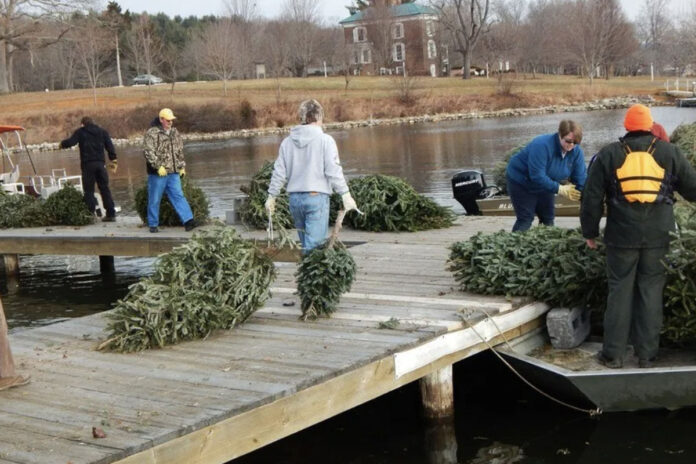
By Danielle Rhea
According to the 2017 Census of Agriculture, more than 14 million live Christmas trees are expected to be cut and sold in the United States in 2022.
While these trees help create a festive atmosphere, one consequence of using a live tree is disposing of it once the season is over. People may opt to participate in community recycling programs, throw their tree in the trash or simply burn it.
This year, consider repurposing your tree to improve fish habitat. When Christmas trees are sunken into water bodies, they increase the complexity of the aquatic habitat. The whorled branching structure of many coniferous trees acts as a refuge from predation by both establishing physical barriers in many different directions and creating shadows that easily camouflage sunfish, perch or other prey species of fish.
Woody debris provides a place for aquatic macroinvertebrates to live, which in turn may attract insect-loving fish, such as rock bass, bluegill and small yellow perch. The overall abundance of fish in and around sunken trees may also attract piscivorous fish, such as smallmouth bass and walleye, and these predators are often found in and around structures that have a plenitude of prey.
In general, studies have found that species richness, diversity and abundance of fish tends to increase with the presence of submerged trees with complex branching.
The first step to recycling a Christmas tree is to remove all ornaments, tinsel and other decorations from the tree.
For Pennsylvania pond owners interested in “sprucing up” their private pond, Christmas trees need to be weighed down prior to placing in the water. This can be done by cementing the trunk into a cement block or 5-gallon bucket. Trees should be placed upright in parts of the pond that are at least deep enough to cover the tree. Placing trees in clusters tends to be more effective at attracting fish than singular trees.
In addition to private pond improvements, organizations such as the U.S. Army Corps of Engineers, U.S. Forest Service, and even state or county parks may collect Christmas trees for implementing structural fish habitat improvement projects in larger lakes and reservoirs.
Many of these agencies use Christmas trees to create larger habitat structures such as brush piles, fish cribs or brush deflectors in publicly managed lakes and reservoirs. Contact your local U.S. Army Corps of Engineers, U.S. Forest Service, or other similar agency to find out if there is a collection program near you.











